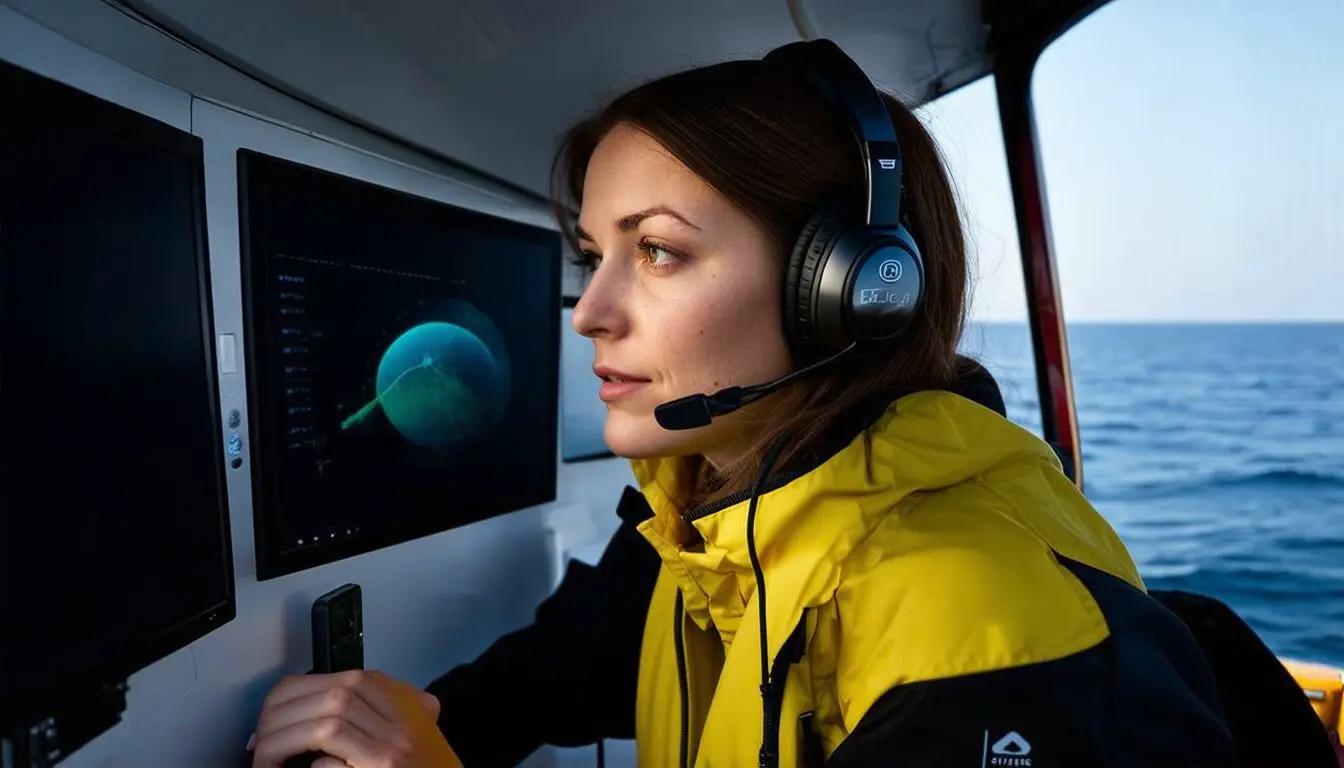August 15, 2024|10 min reading
Unlocking the Mysteries of Whale Communication with AI: The Sound of Sperm Whales and the Future of Marine Research

In the vast, mysterious oceans, whales have long been regarded as enigmatic giants. These magnificent creatures, particularly sperm whales, have fascinated humans for centuries. The haunting sounds they produce—clicks, whistles, and songs—were once mere curiosities. But, it wasn't until the 1970s that researchers began to unravel the complex communication systems of these marine mammals. This marked the dawn of a new era in understanding whale behavior and culture. With advancements in technology, particularly the rise of AI and language models like ChatGPT, we are on the brink of decoding these underwater languages, potentially unlocking a new realm of interspecies communication.
The Sound of a Sperm Whale: A Gateway to Understanding
The deep clicks of sperm whales are among the loudest sounds in the animal kingdom, capable of traveling vast distances underwater. Initially perceived as random noises, these clicks are now understood to be a sophisticated form of communication. Researchers discovered that these sounds are not just for navigation or echolocation but also serve social and cultural purposes. The sperm whale's brain is highly developed, supporting complex social structures and behaviors that are communicated through these vocalizations.
Each click sequence, known as a "coda," varies between whale families and regions, much like dialects in human languages. These codas are used for everything from identifying individuals to maintaining group cohesion. The realization that whales use a structured form of communication has opened up exciting possibilities for understanding their social lives and, ultimately, their culture.
The Evolution of Bioacoustics: Decoding Marine Mammal Sounds
Bioacoustics, the study of sound production and hearing in animals, has become a pivotal field in marine research. This discipline has revealed that many marine species, including whales, use sound as a primary means of communication. In the case of sperm whales, bioacoustics has been instrumental in identifying the patterns and structures within their clicks.
In the 1970s, scientists began recording whale sounds systematically, leading to the discovery that these vocalizations often followed specific sequences. This was a groundbreaking revelation, suggesting that whale communication might share similarities with human language in terms of syntax and grammar.
The implications of this discovery were profound. It suggested that whales could convey complex information through their sounds, potentially even expressing emotions or intentions. However, despite these advances, fully deciphering whale communication remained elusive—until now.
AI and Language Models: A New Frontier in Whale Research
The development of AI and machine learning, particularly language models like ChatGPT, has revolutionized our approach to studying non-human languages. These models, which are capable of processing vast amounts of data and recognizing patterns, offer a powerful tool for decoding the complex vocalizations of whales.
Language models have proven remarkably effective at translating human languages by identifying and mapping semantic relationships between words. When applied to whale communication, these models could potentially unlock the meaning behind the clicks and codas of sperm whales.
The idea is that, just as AI can learn the nuances of human language through exposure to large datasets, it might also learn the 'language' of whales by analyzing extensive recordings of their vocalizations. This approach could reveal the structure of whale communication and perhaps even the meanings behind specific sounds.
The Cultural Significance of Whale Communication
One of the most intriguing aspects of whale communication is its cultural dimension. Research has shown that certain whale groups develop unique vocal traditions that are passed down through generations. For instance, different populations of sperm whales have distinct codas, which serve as cultural markers.
These vocal traditions can spread across vast distances, influencing other groups. This phenomenon mirrors cultural diffusion in human societies, where practices, languages, and traditions are shared and adapted by different communities.
The potential to decode these cultural transmissions in whale communication could offer unprecedented insights into the social lives of these animals. It might even lead to a deeper understanding of the evolution of culture in non-human species.
The Role of Bioacoustics in Conservation
Beyond understanding whale communication, bioacoustics plays a critical role in conservation efforts. By monitoring whale sounds, researchers can track the movements and behaviors of these animals, providing valuable data for protecting endangered species.
For example, bioacoustic monitoring has been used to identify critical habitats for whales, ensuring that these areas are protected from human activities such as shipping and fishing. Additionally, understanding the impact of noise pollution on whale communication is essential for developing strategies to mitigate its effects.
As AI continues to advance, the integration of machine learning with bioacoustic research could enhance our ability to monitor and protect marine life. This technology could enable real-time analysis of whale sounds, allowing for more responsive conservation measures.
Challenges and Ethical Considerations
While the potential of AI in decoding whale communication is exciting, it also raises significant challenges and ethical questions. One of the primary concerns is the risk of anthropomorphizing whale behavior—interpreting their sounds through a human lens without fully understanding the context.
Moreover, there is the potential impact on whale populations if humans begin to replicate or interfere with their communication. For instance, broadcasting artificial whale sounds could disrupt natural behaviors, leading to unforeseen consequences for these animals.
To mitigate these risks, researchers must approach this work with caution, ensuring that their findings are based on robust data and that any interventions are carefully controlled. The ultimate goal should be to enhance our understanding of whale communication in a way that respects the integrity of these animals and their ecosystems.
Looking to the Future: The Promise of AI in Marine Research
As we continue to explore the depths of the ocean, the potential for AI to transform marine research is immense. The ability to decode whale communication could revolutionize our understanding of these creatures, revealing the full complexity of their social structures, cultures, and interactions.
In the future, we might even reach a point where we can communicate with whales on a basic level, opening up new possibilities for interspecies understanding. This could have profound implications not only for marine biology but also for our broader understanding of intelligence and communication in the animal kingdom.
The journey to decipher whale communication is just beginning, and it is one that requires collaboration between AI researchers, marine biologists, and conservationists. Together, they can unlock the secrets of the deep and ensure that these magnificent creatures are protected for generations to come.
FAQs
What is the significance of sperm whale clicks?
Sperm whale clicks are used for communication and echolocation. These clicks form complex sequences known as codas, which are unique to different whale groups and serve various social functions.
How does bioacoustics help in marine research?
Bioacoustics allows researchers to study the sounds produced by marine animals, providing insights into their behavior, communication, and population dynamics. It is also crucial for monitoring endangered species and their habitats.
Can AI really decode whale communication?
While AI has shown promise in recognizing patterns in whale vocalizations, fully decoding whale communication remains a challenge. However, advancements in language models may bring us closer to understanding these complex sounds.
What are the ethical concerns of using AI in marine research?
One major concern is the risk of disrupting natural whale behaviors through artificial sounds. There is also the danger of misinterpreting whale communication by projecting human attributes onto these animals.
How do sperm whales use their vocalizations socially?
Sperm whales use vocalizations to maintain group cohesion, identify individuals, and convey information. These sounds can vary between different whale groups, much like dialects in human languages.
What is the future of AI in marine research?
AI has the potential to revolutionize marine research by providing new tools for decoding animal communication, monitoring species, and informing conservation efforts. However, it must be used responsibly to avoid unintended consequences.
Explore more

Sora Video Generation Launch: Revolutionizing Creative AI
Discover the groundbreaking Sora video product launch, redefining AI-powered creative tools for global users.

The Race for Artificial General Intelligence: Superintelligence and Society
Explore the debate on artificial general intelligence and superintelligence, featuring expert insights on its possibilit...

NVIDIA and Japan: Driving the AI Revolution in Industry
Explore NVIDIA's role in Japan’s AI revolution, from AI agents to robotics, reshaping industries and powering innovation...
